大学英语语法2——宾语补语
语法中的宾语补语的种类和用法
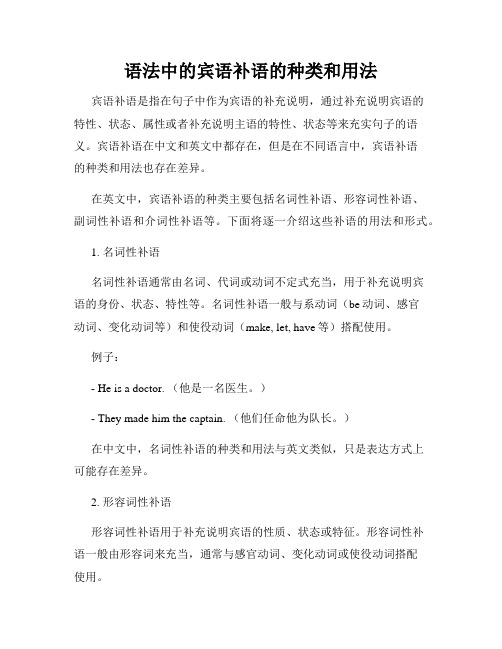
语法中的宾语补语的种类和用法宾语补语是指在句子中作为宾语的补充说明,通过补充说明宾语的特性、状态、属性或者补充说明主语的特性、状态等来充实句子的语义。
宾语补语在中文和英文中都存在,但是在不同语言中,宾语补语的种类和用法也存在差异。
在英文中,宾语补语的种类主要包括名词性补语、形容词性补语、副词性补语和介词性补语等。
下面将逐一介绍这些补语的用法和形式。
1. 名词性补语名词性补语通常由名词、代词或动词不定式充当,用于补充说明宾语的身份、状态、特性等。
名词性补语一般与系动词(be动词、感官动词、变化动词等)和使役动词(make, let, have等)搭配使用。
例子:- He is a doctor. (他是一名医生。
)- They made him the captain. (他们任命他为队长。
)在中文中,名词性补语的种类和用法与英文类似,只是表达方式上可能存在差异。
2. 形容词性补语形容词性补语用于补充说明宾语的性质、状态或特征。
形容词性补语一般由形容词来充当,通常与感官动词、变化动词或使役动词搭配使用。
例子:- She found the movie interesting. (她觉得这部电影很有趣。
)- We painted the wall blue. (我们把墙涂成了蓝色。
)3. 副词性补语副词性补语用于补充说明宾语的程度、方式、地点等。
副词性补语通常由副词或介词短语来充当,用于补充说明宾语的特性。
例子:- We drove the car slowly. (我们慢慢地开车。
)- She cooked the meal in the kitchen. (她在厨房里做饭。
)4. 介词性补语介词性补语用于补充说明宾语的位置、方向或地点等。
介词性补语通常由介词短语来充当,用于补充说明宾语的特性。
例子:- The cat climbed onto the tree. (猫爬上了树。
)- We put the books on the table. (我们把书放在桌子上。
大学英语语法2——宾语补语
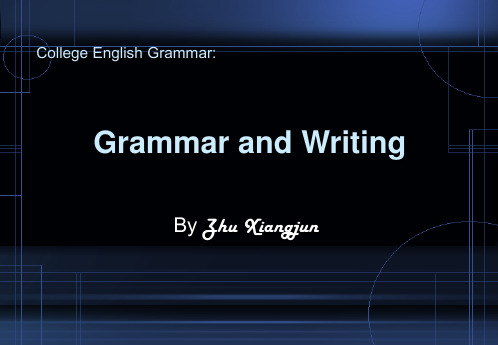
1. The man handed a photo of a girl. The photo was to me. He did that silently. The man was old. The girl was pretty.
• The old man caught a big fish. • Her husband frequently beat her. • My uncle eventually gave up smoking.
Sometimes action verbs have two different objects: direct object and indirect object. Direct object is the receiver of the action while an indirect object is the receiver of the direct object. For instance:
or other nominal as the subject of the sentence and an intransitive verb or verb phrase as the predicate. • Dead dog don’t bite. • Money talks.
Structure 2: S-IV-C • The words acting as a predicative may be a prepositional
He proudly became a boss of a book-store for the first time in his life.
《宾语补足语》课件

宾语补足语是指出现在及物动词后,表示对宾语的补充和说明的成分。它起 到限定和修饰宾语的作用,帮助我们更准确地了解宾语所表示的意义。
什么是宾语补足语
1 定义
2 作用
宾语补足语是及物动词后的修饰成分,用 来补充、说明宾语的意义。它可以是名词、 形容词、不定式或动名词。
宾语补足语能够进一步限定和修饰宾语, 使句子更加准确、丰富和生动。它提供了 宾语所表示意义的重要信息。
3 所属补足语
名词可以用来表示宾语所属的范围、所有关系或归属关系,如"公司","家庭"。
不定式作宾语补足语
目的补足语
不定式可以表示宾语的目的或 意图,如"学习英语","为了提 高技能"。
结果补足语
不定式可以表示宾语的结果或 效果,如"赚很多钱","使世界 更美好"。
补充说明
不定式可以用来补充说明宾语 的具体内容或方法,如"解决问 题","如何达到目标"。
宾语补足语的位置
宾语补足语通常紧跟在及物动词后面,与宾语一起形成一个整体,如"我发现他很有才华"。 但是有时宾语补足语也可以位于宾语之后,形成一个独立的谓语补足结构,如"我发现他是一个有才华 的人"。
宾语补足语的语态
宾语补足语的语态要和及物动词保持一致。
主动语态
当及物动词处于主动语态时,宾语补足语使 用主动形式,如"我帮助他解决问题"。
2
表达感受
形容词可以用来描述人的情感或感受,如"快乐的笑容","悲伤的故事"。
宾语补足语和主语补足语

4. The book was thrown into a dustbin. 那本书曾被扔进 垃圾箱。into a dustben 是主补。 5. The boy was made to work hard 10 hours a day. 那 男孩曾被迫一天干 10 小时的重活。to work hard 是主补。 6. The water was kept boiling for ten minutes. 水被保持 沸腾 10 分钟。boiling 是主补。 7. The cup was found broken. 茶杯被发现已打破了。 broken 是主补。
2.由-ing 形式或过去分词充当。 1).当宾语补足语的动作由作宾语的名词或代词发出时,宾语 补足语用-ing 形式。 eg. He could hear his heart beating fast. 他可以听见自己的心脏跳得很快。 Do you smell something buring? 你闻到烧焦的气味了 吗?
2).当宾语是宾语补足语发出的动作对象时,宾语补足语用过 去分词形式。 eg.
You'd better have the desk painted.你最好请人把课 桌漆一下。 I've never heard the song sung.我从未听见那首歌被 人唱过。
3.由名词充当。 某些动词 call, name, make, elect, think, find, consider, appoint 后接名词或代词作其语,再接名词作宾 语补足语,补充说明宾语的身份。 eg. He made her secretary.他挑选她当秘书。 Her parents died, leaving her an orphan. 她父母双亡,使她成了孤儿。 They considered Paris the brain and heart of the country. 他们把巴黎看作国家的大脑和心脏。
(完整版)英语宾语补足语用法详解
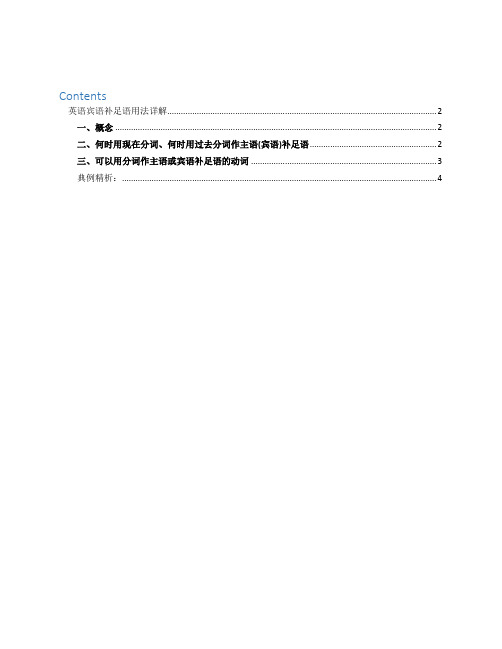
Contents英语宾语补足语用法详解 (2)一、概念 (2)二、何时用现在分词、何时用过去分词作主语(宾语)补足语 (2)三、可以用分词作主语或宾语补足语的动词 (3)典例精析: (4)英语宾语补足语用法详解一、概念分词作主语补足语和宾语补足语其实是同一成分用于两种不同的句式中。
具体地说,主动态句子中的宾语补足语就是被动态句子中的主语补足语。
先了解宾语补足语,则很容易了解主语补足语。
宾语补足语:在英语中,某些及物动词不仅需要宾语,而且还要求某个词或词组来补充说明宾语,即表示宾语代表的人或物所发出的动作或所处的状态,这个词或短语称为宾语补足语。
有些语法书把宾语和补足语称为复合宾语。
句型:及物动词+宾语(n./pron.)+宾语补足语(n./adj./adv./to do/-ing/-ed/介词短语共7种表示法)该句型若变成被动语态,即将宾语提到句首作主语,原主动语态中的宾语补足语此时在被动语态中起到补充说明主语的作用,所以改称主语补足语。
例如:A cook will be immediately fired if he is found smoking in the kitchen.此句中smoking是主语he的补足语,所以称为主语补足语。
二、何时用现在分词、何时用过去分词作主语(宾语)补足语分词作主语(宾语)补足语时,若主语(宾语)与分词之间是主动关系,则用现在分词表示主动;如果主语(宾语)与分词之间是被动关系,则用过去分词表示被动。
例如:He was heard singing in the next room.He was singing.主语he与补足语“唱歌”之间是主动关系,故用现在分词singing。
One of the glasses was found broken.One of the glasses was broken.主语one of the glasses与补足语“打破”之间是被动关系,故用过去分词broken。
英语中宾语补足语和主语补足语的区别
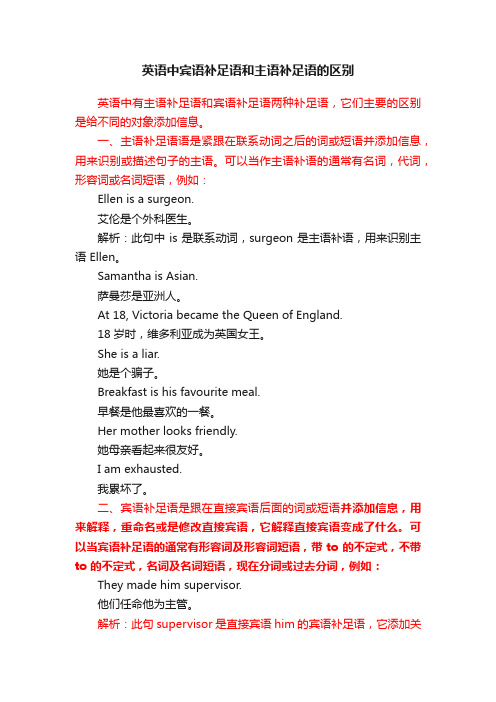
英语中宾语补足语和主语补足语的区别英语中有主语补足语和宾语补足语两种补足语,它们主要的区别是给不同的对象添加信息。
一、主语补足语语是紧跟在联系动词之后的词或短语并添加信息,用来识别或描述句子的主语。
可以当作主语补语的通常有名词,代词,形容词或名词短语,例如:Ellen is a surgeon.艾伦是个外科医生。
解析:此句中 is 是联系动词,surgeon 是主语补语,用来识别主语 Ellen。
Samantha is Asian.萨曼莎是亚洲人。
At 18, Victoria became the Queen of England.18岁时,维多利亚成为英国女王。
She is a liar.她是个骗子。
Breakfast is his favourite meal.早餐是他最喜欢的一餐。
Her mother looks friendly.她母亲看起来很友好。
I am exhausted.我累坏了。
二、宾语补足语是跟在直接宾语后面的词或短语并添加信息,用来解释,重命名或是修改直接宾语,它解释直接宾语变成了什么。
可以当宾语补足语的通常有形容词及形容词短语,带 to 的不定式,不带to 的不定式,名词及名词短语,现在分词或过去分词,例如:They made him supervisor.他们任命他为主管。
解析:此句 supervisor 是直接宾语 him 的宾语补足语,它添加关于 him 的额外信息。
I painted his face green.我把他的脸涂成绿色。
解析:此句 green 是直接宾语 his face 的宾语补足语,它用来解释 his face 的状态。
They did not expect us to win an award.他们没想到我们会得奖。
This dress makes me look fat.这衣服我穿着显胖。
I heard someone singing.我听到有人在唱歌。
宾语补足语是什么与双宾语有什么区别
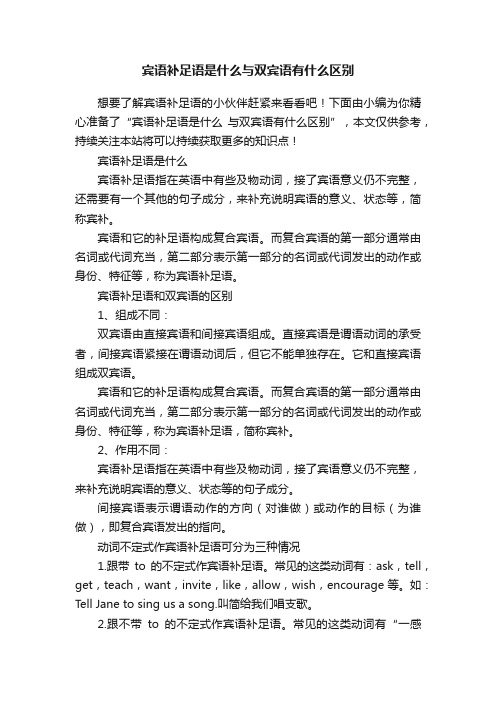
宾语补足语是什么与双宾语有什么区别想要了解宾语补足语的小伙伴赶紧来看看吧!下面由小编为你精心准备了“宾语补足语是什么与双宾语有什么区别”,本文仅供参考,持续关注本站将可以持续获取更多的知识点!宾语补足语是什么宾语补足语指在英语中有些及物动词,接了宾语意义仍不完整,还需要有一个其他的句子成分,来补充说明宾语的意义、状态等,简称宾补。
宾语和它的补足语构成复合宾语。
而复合宾语的第一部分通常由名词或代词充当,第二部分表示第一部分的名词或代词发出的动作或身份、特征等,称为宾语补足语。
宾语补足语和双宾语的区别1、组成不同:双宾语由直接宾语和间接宾语组成。
直接宾语是谓语动词的承受者,间接宾语紧接在谓语动词后,但它不能单独存在。
它和直接宾语组成双宾语。
宾语和它的补足语构成复合宾语。
而复合宾语的第一部分通常由名词或代词充当,第二部分表示第一部分的名词或代词发出的动作或身份、特征等,称为宾语补足语,简称宾补。
2、作用不同:宾语补足语指在英语中有些及物动词,接了宾语意义仍不完整,来补充说明宾语的意义、状态等的句子成分。
间接宾语表示谓语动作的方向(对谁做)或动作的目标(为谁做),即复合宾语发出的指向。
动词不定式作宾语补足语可分为三种情况1.跟带to的不定式作宾语补足语。
常见的这类动词有:ask,tell,get,teach,want,invite,like,allow,wish,encourage等。
如:Tell Jane to sing us a song.叫简给我们唱支歌。
2.跟不带to的不定式作宾语补足语。
常见的这类动词有“一感(feel)、二听(listen to,hear),三让(make,let,have),四看(look at,see,watch,notice)如:Let’s have a rest.让我们休息一会儿。
但这种结构变成被动语态时,to必须加上。
如:He was seen to leave the room with a book in his hand.有人见他手拿着一本书离开这个房间。
宾语补足知识点总结

宾语补足知识点总结一、宾语补足语(宾补)宾语补足语(宾补)是指在及物动词后所需的宾语后面,充当宾语补足的成分,通常由名词、形容词或动词不定式构成。
宾补通常有以下几种类型:1. 名词宾语补足语:通常由名词、代词、数词等构成。
例如:I consider him (to be) my friend.(我认为他是我的朋友。
)2. 形容词宾语补足语:通常由形容词构成。
例如:They found the film (interesting).(他们觉得那部电影很有趣。
)3. 动词不定式宾语补足语:通常由动词不定式构成。
例如:I wanted (to go) there.(我想去那里。
)二、宾语补足成分(宾补成分)宾语补足成分(宾补成分)是指在及物动词后所需的宾语之后,作为宾语补足的成分,通常由名词、代词、形容词或动词不定式构成。
宾补成分的构成形式和用法与宾补基本相同。
三、宾语补足的构成形式宾语补足的构成形式包括:名词补语、形容词补语、副词补语和动词不定式补语。
其中,名词补语、形容词补语和动词不定式补语是比较常见的形式,而副词补语出现的频率较低。
四、宾语补足的用法1. 宾语补足的用法主要包括以下几个方面:(1)表示动作的结果或状态:通常由形容词或动词不定式构成。
例如:He made me (angry).(他惹怒了我。
)(2)表示宾语的补充说明:用于对宾语进行补充或说明。
例如:I find the book (interesting).(我觉得这本书很有趣。
)(3)表示动词的意义:通常由动词不定式构成。
例如:I saw him (go out).(我看见他走出去了。
)2. 在实际应用中,宾语补足通常需符合以下几个原则:(1)宾语补足通常应与及物动词构成逻辑上的完整意思。
(2)宾语补足通常应与及物动词一起构成句子的谓语动词。
(3)宾语补足通常应与及物动词构成合理的语法结构。
五、宾语补足的误用在英语中,有些人容易在使用宾语补足时出现误用。
- 1、下载文档前请自行甄别文档内容的完整性,平台不提供额外的编辑、内容补充、找答案等附加服务。
- 2、"仅部分预览"的文档,不可在线预览部分如存在完整性等问题,可反馈申请退款(可完整预览的文档不适用该条件!)。
- 3、如文档侵犯您的权益,请联系客服反馈,我们会尽快为您处理(人工客服工作时间:9:00-18:30)。
4. It occurred a short while ago. My brother helped me. We carried a bookcase up the stairs. The bookcase was very heavy.
• Poverty tries friends.
• The Liberian handed me a Spanish dictionary.
Structure 4: S-P-O-A
The words acting as an adverbial can be adverbs, prepositional phrases, or adverbial clauses, providing information about time, place, manner, and reasons.
or other nominal as the subject of the sentence and an intransitive verb or verb phrase as the predicate. • Dead dog don’t bite. • Money talks.
Structure 2: S-IV-C • The words acting as a predicative may be a prepositional
At last the firemen have put out a big forest fire in Califotructures
Structure 1: S-P • The S-P sentence structure is made up of a noun, pronoun,
2. The old man silently handed a photo of a pretty girl to me.
2. It was the first time in his life. He became a boss. He was proud. He owned a book-store.
• My favorite playwright is William Shakespeare. • Mark Twain became a pilot on a steamboat. • She felt uneasy in the crowd.
The complement of an action verb is called an object. Subject is the doer of the action, and the object is the receiver of the action.
• The villagers found their bedrooms ankle-deep in water.
• The friendly mood makes us comfortable.
Exercises 2: Combine the sentences
1. I felt pleased with my bargain My pleasure was especial. My bargain was wonderful.
• 2. Jim presented his girl friend a bunch of flowers. (Jim presented a bunch of flowers to his girl friend.)
Adverbials indicates time, place, manner, and reasons. They answer questions such as when, where, how and why. Adverbials can be adverbs, prepositional phrases, or adverbial clauses.
• Harry bought his son a new school-bag.
Usually, a preposition “to” or “for” can be put in front of the indirect object. For example,
• 1. The old man left his daughter a large house. (The old man left a large house for his daughter.)
phrase to show the place of the subject, or a noun to identify or rename the subject, or an adjective to indicate the state of the subject. • Speech is the picture of mind. • The firemen are inside the building.
As a rule, a long adverbial are placed at the end of a sentence, while short adverbials are flexible to locate: at the beginning, in the middle or at the end may be all right. For instance
3. Advertising exerts an influence. The influence is subtle. The influence is on children.
Advertising exerts a subtle influence on children.
4. I was being tested. The test was for a driving license. It was the third time.
that many combinations are possible, and there's no single correct one.
1. The man handed a photo of a girl. The photo was to me. He did that silently. The man was old. The girl was pretty.
2. I felt especially pleased with my wonderful bargain.
2. People find this sort of joke. These people are foreign. This sort of joke are distasteful.
Foreign people find this sort of joke distasteful.
1. The train will arrive next morning. 2. He carefully drove his car to the station. 3. Very soon, she knew the full story.
Exercises 1: Combine the sentences in each set into a single clear sentence. Omit words that are needlessly repeated, but don't leave out any important details. Keep in mind
• You never miss the water till the well runs dry.
• No man can make a good coat with bad cloth.
Structure 5: S-P-O -OC
Different from an indirect object which is the receiver of the direct object, an object complement is to complete the meaning of the direct object. The words acting as an object complement can be nouns, adjectives or prepositional phrases.
Object and complement
Generally, verbs can be put into two: linking verbs and action verbs. Both of them require a word to complete their meaning. We can call such a word complement. The complement of a linking verb is called a predicative or a subject complement, which describes or renames the subject. For example:
大学英语语法2——宾语补语
Unit 2
Basic parts of a sentence (II)
• Grammar:
1. Object and complement 2.Basic sentence structures
• Writing: Correcting: Run-on Sentence Rewriting: The importance of the subject
He proudly became a boss of a book-store for the first time in his life.
